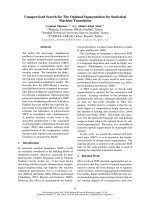Large neighborhood local search for the p-median problem
Bạn đang xem bản rút gọn của tài liệu. Xem và tải ngay bản đầy đủ của tài liệu tại đây (137.17 KB, 11 trang )
Yugoslav Journal of Operations Research
15 (2005), Number 1, 53-63
LARGE NEIGHBORHOOD LOCAL SEARCH
FOR THE P-MEDIAN PROBLEM
Yuri KOCHETOV, Ekaterina ALEKSEEVA
Tatyana LEVANOVA, Maxim LORESH
Sobolev Institute of Mathematics, Russia
Presented at XXX Yugoslav Simposium on Operations Research
Received: January 2004 / Accepted: January 2005
Abstract: In this paper we consider the well known p-median problem. We introduce a
new large neighborhood based on ideas of S.Lin and B.W. Kernighan for the graph
partition problem. We study the behavior of the local improvement and Ant Colony
algorithms with new neighborhood. Computational experiments show that the local
improvement algorithm with the neighborhood is fast and finds feasible solutions with
small relative error. The Ant Colony algorithm with new neighborhood as a rule finds an
optimal solution for computationally difficult test instances.
Keywords: Large neighborhood, Lagrangean relaxations, ant colony, p-median, benchmarks.
1. INTRODUCTION
In the p-median problem we are given a set I ={1,…, m} of m potential locations
for p facilities, a set J ={1,…, n} of n customers, and a n×m matrix (gij) of transportation
costs for servicing the customers by the facilities. If a facility i can not serve a customer j
then we assume gij = +∞. Our gain is to find a feasible subset S ⊂ I, |S| = p such that
minimizes the objective function
F ( S ) = ∑ min gij .
j∈ J
i∈S
This problem is NP-hard in strong sense. So, the metaheuristics such as Ant
Colony, Variable Neighborhood Search and others [7] are the most appropriate tools for
the problem.
In this paper we introduce a new large neighborhood based on ideas of S.Lin
and B.W. Kernighan for the graph partition problem [9]. We study the behavior of the
local improvement algorithm with different starting points: optimal solutions of
54
Y. Kochetov, E. Alekseeva, T. Levanova, M. Loresh / Large Neighborhood Local Search
Lagrangean relaxation randomized rounding of optimal solution for the linear
programming relaxation, and random starting points. Computational experiments show
that the local improvement algorithm with new neighborhood is fast and finds feasible
solutions with small relative error for all starting points. Moreover, the Ant Colony
heuristic with new neighborhood as a rule finds an optimal solution for computational
difficult test instances.
The paper is organized as follows. In section 2 we describe Swap, k-Swap and
Lin-Kernighan neighborhoods for the p-median problem. Section 3 presents Lagrangean
relaxation and randomized rounding procedures for selecting of starting points for the
local improvement algorithm. The framework of Ant Colony heuristic is considered in
section 4. Finally, the difficult test instances and computational results are discussed in
sections 5 and 6. In section 7 we give conclusions and further research directions.
2. ADAPTIVE NEIGHBORHOODS
Standard local improvement algorithm starts from an initial solution and moves
to a better neighboring solution until it terminates at a local optimum. For a subset S the
Swap neighborhood contains all subsets S′ , |S′ | = p, with Hamming distance from S′ to
S at most 2:
Swap ( S ) = {S ′ ⊂ I
| S ' |= p, d ( S , S ′) ≤ 2} .
By analogy, the k-Swap neighborhood is defined as follows:
k - Swap ( S ) = {S ′ ⊂ I
| S ′ |= p, d ( S , S ′) ≤ 2k }.
Finding the best element in the k-Swap neighborhood requires high efforts for
large k. So, we introduce a new neighborhood which is a part of the k-Swap
neighborhood and based on the greedy strategy [1].
Let us define the Lin-Kernighan neighborhood (LK) for the p-median problem.
For the subset S it consists of k elements, k ≤ n – p, and can be described by the following
steps.
Step 1. Choose two facilities iins∈ I \ S and irem∈S such that F(S ∪{iins}\{irem}) is
minimal even if it greater than F(S).
Step 2. Perform exchange of irem and iins.
Step 3. Repeat steps 1, 2 k times so that a facility can not be chosen to be inserted in S if
it has been removed from S in one of the previous iterations of step 1 and step 2.
τ
, iτrem )}τ ≤ k defines k neighbors Sτ for the subset S. The best
The sequence {(iins
element in the Swap neighborhood can be found in O(nm) time [12]. Hence, we can find
the best element in the LK-neighborhood in O(knm) time. We say that S is a local
minimum with respect to the LK-neighborhood if F(S) ≤ F(Sτ) for all τ ≤ k. Any local
minimum with respect to the LK-neighborhood is a local minimum with respect to the
Swap neighborhood and may be not a local minimum with respect to the k-Swap
neighborhood.
Y. Kochetov, E. Alekseeva, T. Levanova, M. Loresh / Large Neighborhood Local Search
55
3. STARTING POINTS
Let us rewrite the p-median problem as a 0-1 program:
min ∑∑ gij yij
(1)
i∈I j∈J
s.t.
∑y
ij
= 1,
j∈J
(2)
i∈I
xi ≥ yij ≥ 0, i ∈ I , j ∈ J
(3)
∑x
(4)
i
=p
i∈I
yij , xi ∈ {0,1}, i ∈ I , j ∈ J .
(5)
In this formulation xi =1 if i∈S and xi = 0 otherwise. Variables yij define a facility
that serves the customer j. We may set yij =1 for a facility i that achieves mini∈S gij and set
yij = 0 otherwise. Lagrangean relaxation with multipliers uj which correspond to equations
(2) is the following program:
L(u ) = min ∑∑ ( gij − u j ) yij + ∑ u j
i∈I j∈J
j∈ J
s.t. (3), (4), (5).
It is easy to find an optimal solution x(u), y(u) of the problem in polynomial time [6].
The dual problem
max L(u )
u
can be solved by subgradient optimization methods, for example, by the Volume
algorithm [2,3]. It produces a sequence of Lagrangean multipliers u tj , t =1,2,…,T, as well
as a sequence of optimal solutions x(ut), y(ut) of the problem L(ut). Moreover, the
algorithm allows us to get an approximation x , y of the optimal solution for the linear
programming relaxation (1)–(4). In order to get starting points for the local improvement
t
algorithm we use optimal solutions x(u ) or apply the randomized rounding procedure to
the fractional solution x .
4. ANT COLONY OPTIMIZATION
The Ant Colony algorithm (AC) was initially proposed by Colorni et al. [5, see
also 7]. The main idea of the approach is to use the statistical information of previously
obtained results to guide the search process into the most promising parts of the feasible
domain. It is iterative procedure. At the each iteration, we construct a prescribed number
of solutions by the following Randomized Drop heuristic (RD):
56
Y. Kochetov, E. Alekseeva, T. Levanova, M. Loresh / Large Neighborhood Local Search
Randomized Drop Heuristic
1.
2.
3.
Put S := I
While | S |> p do
2.1 Select i ∈ S at random
2.2 Update S : = S \ {i}
Apply the local improvement algorithm to S.
The step 2.1 is crucial in the heuristic. To select an element i we should bear in
mind the variation of the objective function ΔFi = F ( S ) − F ( S \ {i}) and additional
information about attractiveness of the element i from the point of view a set of local
optima obtained at the previous iterations. To realize the strategy, we define a candidate
set by the following:
S (λ ) = {i ∈ S | ΔFi ≤ (1 − λ ) min ΔFl + λ max ΔFl } for λ ∈(0,1) .
l∈S
l∈S
At the step 2.1, the element i is selected in S (λ ) instead of the set S .
Probability pi to draw an element i depends on the variation ΔFi and a value α i that
expresses a priority of i to remove from the set S . More exactly, the probability pi is
defined as follows:
pi =
α i (max ΔFl − ΔFi + ε )
∑
k ∈S ( λ )
l∈S
α k (max ΔFl − ΔFk + ε )
,
i ∈ S (λ ) ,
l∈S
where ε is a small positive number. To define α i we present the framework of AC.
AC algorithm (α 0 , T , K , K )
1.
2.
Put α i := 1, i ∈ I , F * := +∞
While t < T do
2.1 Compute local optima S1 ,… , S K by the RD heuristic
2.2 Select K minimal local optima: F ( S1 ) ≤ F ( S2 ) ≤ … ≤ F ( S K ), K < K
2.3 Update α i , i ∈ I using S1 ,… , S K
2.4 If F * > F ( S1 ) then
2.4.1 F * := F ( S1 )
2.4.2 S * := S1
2.4.3 α := α 0 , i ∈ S *
i
*
3. Return S
Y. Kochetov, E. Alekseeva, T. Levanova, M. Loresh / Large Neighborhood Local Search
57
The algorithm has four control parameters:
α 0 : the minimal admissible value of α i , i ∈ I ;
T : the maximal number of the iterations;
K : the number of local optima obtained with fixed values of α i , i ∈ I ;
K : the number of local optima which used to update of α i , i ∈ I .
At the step 2.3, we have the local optima S1 ,… , S K and compute the frequency
γ i of opening facility i in the solutions S1 ,… , S K . If γ i = 0 then the facility i is closed in
all solutions S1 ,… , S K . To modify α i we use the following rule:
α i :=
α 0 + qγ i (α i − α 0 )
, i∈I ,
β
where control parameters 0 < q < 1, 0 < β < 1 are used to manage the adaptation.
5. COMPUTATIONALLY DIFFICULT INSTANCES
5.1. Polynomially solvable instances
Let us consider a finite projective plane of order k [8]. It is a collection of n =
k2 + k + 1 points p1,…, pn and lines L1,…, Ln. An incidence matrix A is an n×n matrix
defining the following: aij = 1 if pj ∈ Li and aij = 0 otherwise. The incidence matrix A
satisfying the following properties:
A has constant row sum k + 1;
A has constant column sum k + 1;
the inner product of any two district rows of A is 1;
the inner product of any two district columns of A is 1.
These matrices exist if k is a power of prime. A set of lines Bj = {Li | pj ∈ Li} is
called a bundle for the point pj. Now we define a class of instances for the p-median
problem. Put I = J = {1,…, n}, p = k + 1 and
⎧⎪ξ , if aij = 1,
gij = ⎨
⎪⎩+∞ otherwise,
where ξ is a random number taken from the set {0, 1, 2, 3, 4} with uniform distribution.
We denote the class of instances by FPPk . From the properties of the matrix A we can get
that an optimal solution for FPPk corresponds to a bundle. Hence, an optimal solution
for the corresponding p-median problem can be found in polynomial time.
Every bundle of the plane accords with a feasible solution of the p-median
problem and vice versa. For any feasible solution S, the (k-1)-Swap neighborhood has
one element only. So, the landscape for the problem with respect to the neighborhood is a
collection of isolated vertices. This case is hard enough for the local search methods if k
is sufficiently large.
58
Y. Kochetov, E. Alekseeva, T. Levanova, M. Loresh / Large Neighborhood Local Search
5.2. Instances with exponential number of strong local optima
Let us consider two classes of instances where number of strong local optima
grows exponentially as dimension increases. The first class uses the binary perfect codes
with code distance 3. The second class is constructed with help a chess board.
5.2.1. Instances based on perfect codes
Let Bk be a set of words or vectors of length k over an alphabet {0, 1}. A binary
code of length k is an arbitrary nonempty subset of Bk. Perfect binary code with distance
3 is a subset C ⊆ Bk, |C|=2k/(k+1) such that Hamming distance d(c1,c2) ≥ 3 for all c1, c2 ∈
C, c1 ≠ c2. These codes exist for k=2r–1, r > 1, integer.
Put n = 2k, I = J = {1,…, n}, and p=|C|. Every element i∈I corresponds to a
vertex v(i) of the binary hyper cube Z k2 . Therefore, we may use Hamming distance
d(v(i), v(j)) for any two elements i, j ∈ I. Now we define
⎧ξ , if d (v(i ), v( j )) ≤ 1,
gij = ⎨
⎩+∞ otherwise,
where ξ is a random number taken in the set {0, 1, 2, 3, 4} with uniform distribution.
The number of perfect codes ℵ(k) grows exponentially as k increases. The best known
lower bound [10] is
k +1
ℵ(k ) ≥ 22
2
−log 2 ( k +1)
k −3
⋅ 32
4
k +5
⋅ 22
4
−log 2 ( k +1)
.
Each feasible solution of the p-median problem corresponds to a binary perfect
code with distance 3 and vice versa. The minimal distance between two perfect codes or
feasible solutions is at least 2(k+1)/2. We denote the class of benchmarks by PCk.
5.2.2. Instance based on a chess board
Let us glue boundaries of the 3k×3k chess board so that we get a torus. Put r =
3k. Each cell of the torus has 8 neighboring cells. For example, the cell (1,1) has the
following neighbors: (1,2), (1,r), (2,1), (2,2), (2,r), (r,1), (r,2), (r,r). Define n = 9k2, I = J
= {1,…,n}, p = k2 , and
⎧ξ , if the cells i, j are neighbors
gij = ⎨
⎩+∞ otherwise,
where ξ is a random number taken from the set {0, 1, 2, 3, 4} with uniform distribution.
The torus is divided into k2 squares by 9 cells in each of them. Every cover of the torus
by k2 squares corresponds to a feasible solution for the p-median problem and vise versa.
The total number of feasible solutions is 2·3k+1–9. The minimal distance between them is
2k. We denote the class of benchmarks by CBk.
Y. Kochetov, E. Alekseeva, T. Levanova, M. Loresh / Large Neighborhood Local Search
59
5.3. Instances with large duality gap
Let the n×n matrix (gij) has the following property: each row and column have
the same number of non-infinite elements. We denote this number by l. The value l/n is
called the density of the matrix. Now we present an algorithm to generate random
matrices (gij) with the fixed density.
Random matrix generator (l,n)
1. J ← {1,…, n}
2. Column [j] ← 0 for all j ∈ J
3. g[i,j] ← + ∞ for all i, j ∈ J
4. for i ← 1 to n
do l0 ← 0
5.
for j ← 1 to n
6.
do if n – i + 1 = l – Column [j]
7.
then g[i, j] ← ξ
8.
9.
l0 ← l0+1
10.
Column [j] ← Column [j]+1
11.
J←J\j
12.
select a subset J′ ⊂ J, | J′| =l – l0 at random and
put g[i,j] ←ξ for j∈ J′
The array Column [j] keeps the number of small elements in j-th column of the
generating matrix. Variable l0 is used to count the columns where small elements must be
located in i-th row. These columns are detected in advance (line 7) and removed from the
set J (line 11). Note that we may get random matrices with exactly l small elements for
each row only if we remove lines 6–11 from the algorithm. By transposing we get
random matrices with this property for columns only. Now we introduce three classes of
benchmarks:
Gap-A: each column of the matrix (gij) has exactly l small elements
Gap-B: each row of the matrix (gij) has exactly l small elements
Gap-C: each column and row of the matrix (gij) has exactly l small elements.
For each instance we define p as a minimal value of facilities which can serve
all customers. In computational experiments we put l = 10, n = m = 100 and p = 12 ÷15.
The instances have significant duality gap:
δ=
Fopt − FLP
Fopt
⋅100%,
where FLP is an optimal solution for the linear programming relaxation. In average, we
observe δ ≈ 35.5% for class Gap-A, δ ≈ 37.6% for class Gap-B, δ ≈ 41.5% for class GapC. For comparison, δ ≈ 9.84% for class FPP11, δ ≈ 14.9% for class CB4, δ ≈ 1.8% for
class PC7.
60
Y. Kochetov, E. Alekseeva, T. Levanova, M. Loresh / Large Neighborhood Local Search
6. COMPUTATIONAL EXPERIMENTS
All algorithms were coded and tested on instances taken from the electronic
benchmarks libraries: the well-known OR Library [4] and new library “Discrete Location
Problems” available by address: All instances are random generated and were solved exactly. For OR
Library instances, the elements gij are Euclidean distances between random points on two
dimensional Euclidean plane. The density of the matrices is 100 %. The problem
parameters range from instances with n = m = 100, p = 5, 10 and up to instances with n =
m = 900, p = 5. Our computational experiments show that the instances are quite easy.
The local improvement algorithm with random starting points and simple restart strategy
with 100 trials finds an optimal solution for instances with n = 100 ÷ 700 if we use Swap
neighborhood. For the LK-neighborhood, the algorithm finds an optimal solution for all
OR Library instances.
The new library “Discrete Local Problems” contains more complicated
instances for the p-median problem. For every class discussed above, 30 test instances
are available. The density of matrices (gij) is small, about 10 % – 16 %. We study the
behavior of the local improvement and Ant Colony algorithms for these tests. Three
variants of local improvement algorithm are considered:
LR: Local improvement with starting points x(ut).
RR: Local improvement with starting points generated by the randomized
rounding procedure applied to the fractional solution x .
Rm: Local improvement with random starting points.
In computational experiments every algorithm finds 120 local optima. The best
of them is returned.
Table 1: Average relative error for the algorithms with Swap neighborhood
Benchmarks
n, p
RR
LR
Rm
Gap-A
Gap-B
Gap-C
FPP11
PC7
CB4
Uniform
100, 12-13
100, 14-15
100, 14
133, 12
128, 16
144, 16
100, 12
1.31
4.79
6.53
0.09
0.07
1.32
0.11
1.34
4.48
5.19
0.07
0.05
1.32
0.05
1.12
5.45
8.65
0.15
3.49
0.96
0.01
AC
0.00
0.00
0.00
0.00
0.00
0.00
0.00
Table 1 presents the average relative error for the algorithms with Swap
neighborhood. For comparison, we include additional Uniform class of test instances.
The elements gij are taken in interval [0, 104] at random with uniform distribution. The
density of the matrices is 100% and p = 12.
Y. Kochetov, E. Alekseeva, T. Levanova, M. Loresh / Large Neighborhood Local Search
61
Table 2: The percent of trials when no feasible solutions obtained by Swap neighborhood
Benchmarks
n, p
RR
LR
Rm
AC
Gap-A
Gap-B
Gap-C
FPP11
PC7
CB4
Uniform
100, 12-13
100, 14-15
100, 14
133, 12
128, 16
144, 16
100, 12
33.50
37.22
34.40
0.00
0.00
6.17
0.00
19.17
37.22
38.07
0.00
0.00
0.50
0.00
15.50
36.11
26.93
0.00
0.33
0.00
0.00
16.11
27.44
20.88
0.00
0.00
0.00
0.00
Table 2 presents a percent of trials when no feasible solutions can be obtained.
By the experiments we may conclude that Ant Colony approach shows the best results.
As a rule, it finds optimal solutions. The local improvement algorithm is weaker.
Nevertheless, it can find feasible solutions with small relative error. It is interesting to
note that LR and RR algorithms [3] without local improvement procedure can not find
feasible solutions for difficult test instances. So, the stage of local improvement is very
important for the p-median problem.
Table 3: Average relative error for the algorithms with LK- neighborhood
Benchmarks
n, p
RR
LR
Rm
Gap-A
Gap-B
Gap-C
FPP11
PC7
CB4
Uniform
100, 12-13
100, 14-15
100, 14
133, 12
128, 16
144, 16
100, 12
0.33
1.08
1.69
0.09
0.05
0.13
0.00
0.51
1.16
1.44
0.07
0.04
0.09
0.00
0.20
0.97
1.61
0.09
2.35
0.00
0.00
AC
0.00
0.00
0.00
0.00
0.00
0.00
0.00
Table 4. The percent of trials when no feasible solutions obtained by LK- neighborhood
Benchmarks
n, p
RR
LR
Rm
AC
Gap-A
Gap-B
Gap-C
FPP11
PC7
CB4
Uniform
100, 12-13
100, 14-15
100, 14
133, 12
128, 16
144, 16
100, 12
10.67
9.67
0.00
0.00
0.00
0.00
0.00
5.78
7.56
0.00
0.00
0.00
0.00
0.00
3.78
7.56
0.00
0.00
0.00
0.00
0.00
4.33
13.44
0.00
0.00
0.00
0.00
0.00
62
Y. Kochetov, E. Alekseeva, T. Levanova, M. Loresh / Large Neighborhood Local Search
Table 5: The average number of steps by the Swap neighborhood to reach a local optimum
Benchmarks
Gap-A
Gap-B
Gap-C
FPP11
PC7
CB4
Uniform
n, p
RR
LR
Rm
AC
100, 12-13
100, 14-15
100, 14
133, 12
128, 16
144, 16
100, 12
6.76
10.24
9.78
7.52
4.77
7.19
6.01
7.70
11.24
10.74
7.89
7.72
8.02
6.25
10.69
11.92
10.74
9.24
12.17
13.93
13.08
5.11
5.85
5.80
5.02
6.39
7.64
5.12
Table 6: The average number of steps by the LK- neighborhood to reach a local optimum
Benchmarks
n, p
RR
LR
Rm
AC
Gap-A
Gap-B
Gap-C
FPP11
PC7
CB4
Uniform
100, 12-13
100, 14-15
100, 14
133, 12
128, 16
144, 16
100, 12
7.85
11.84
10.78
0.39
0.4
11.00
4.57
7.81
11.68
10.50
0.34
0.85
10.95
4.18
9.28
2.59
11.70
0.29
2.04
15.72
7.49
0.67
0.84
0.89
0.017
0.19
0.58
0.38
Table 3 and 4 show results for the LK-neighborhood. Comparison these tables
and two previous ones persuade that the LK-neighborhood allows to improve the
performance of the algorithms indeed. We get feasible solutions more often. The relative
error decreases. Tables 5 and 6 present average number of steps by Swap and LKneighborhoods to reach a local optimum. As we can see, a path from starting points to
local optima is shot enough.
7. CONCLUSIONS
In this paper we have introduced a new promising neighborhood for the pmedian problem. It contains at most n–p elements and allows the local improvement
algorithm to find near optimal solutions for difficult test instances and optimal solutions
for Euclidean instances with middle dimensions. We hope this new neighborhood will be
useful for more powerful meta-heuristics [7]. For example, the Ant Colony algorithm
with LK-neighborhood shows excellent results for all test instances considered.
Another interesting direction for research is computational complexity of the
local search procedure with Swap and LK-neighborhoods for the p-median problem. It
seems plausible that the problem is PLS-complete from the point of view of the worst
case analysis [15], but is solvable polynomially in average case [14].
Acknowledgment: This research was supported by the Russian Foundation for Basic
Research, grant 03-01-00455.
Y. Kochetov, E. Alekseeva, T. Levanova, M. Loresh / Large Neighborhood Local Search
63
REFERENCES
[1]
[2]
[3]
[4]
[5]
[6]
[7]
[8]
[9]
[10]
[11]
[12]
[13]
[14]
[15]
Ahuja, R.K., James, O.E., Orlin, B., and Punnen, A.P., "A survey of very large-scale
neighborhood search techniques", Discrete Applied Mathematics, 123 (2002) 75–102.
Barahona, F., and Anbil, R., "The volume algorithm: producing primal solutions with a
subgradient method", Mathematical Programming, Ser.A, 87 (2000) 385–399.
Barahona, F., and Chudak, F.A., "Solving large scale uncapacitated facility location
problems", in: Pardalos P.M. (ed.), Approximation and Complexity in Numerical
Optimization: Continuous and Discrete Problems, Kluwer Academic Publishers, 1999.
Beasley, J.E., "OR-Library: Distributing test problems by electronic mail", Journal of the
Operational Research Society, 41(11) (1990) 1069-1072.
Colorny, A., Dorigo, M., and Maniezzo, V., "Distributed optimization by ant colonies",
Proceedings of the 1991 European Conference on Artificial Life, 1991, 134-142.
Erlenkotter, D., "A dual-based procedure for uncapacitated facility location", Operations
Research, 26 (1978) 992–1009.
Hansen, P., and Mladenović, N., "An introduction to variable neighborhood search", in:
S.Voss et al. (eds.), Metaheuristics, Advances and Trends in Local Search Paradigms for
Optimization, Kluwer Academic Publishers, Dorchester, 1998.
Hall, M. Jr., Combinatorial Theory, Blaisdell, Waltham, MA, 1967.
Kernighan, B.W., and Lin, S., "An effective heuristic procedure for partitioning graphs", Bell
System Technical Journal, 49 (1970) 291–307.
Krotov, D.S., "Lower bounds for number of m- quasi groups of order 4 and number of perfect
binary codes", Discrete Analysis and Operations Research, Ser.1, 7(2) (2000) 47-53. (in
Russian)
Mirchandani, P.B., and Francis, R.L. (eds.), Discrete Location Theory, Wiley-Interscience,
1990.
Resende, M.G.C., and Werneck, R.F., "On the implementation of a swap-based local search
procedure for the p-median problem", in: R.E. Lander (ed.), Proceedings of the Fifth
Workshop on Algorithm Engineering and Experiments (ALENEX’03), SIAM, 2003, 119-127,
Nemhauser, G.L., and Wolsey, L.A., Integer and Combinatorial Optimization, John Wiley &
Sons, 1988.
Tovey, C.A., "Local improvement on discrete structures", in: E.H.L. Aarts, J.K. Lenstra (eds.),
Local Search in Combinatorial Optimization, Wiley, Chichester, 1997.
Yannakakis, M., "Computational complexity", in: E.H.L.Aarts, J.K.Lenstra (eds.), Local
Search in Combinatorial Optimization, Wiley, Chichester, 1997.









